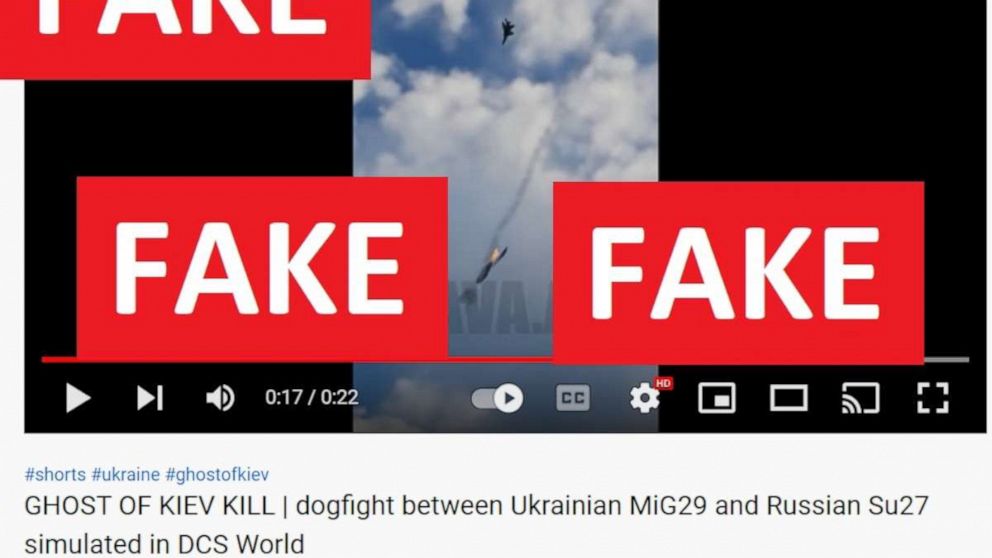How ABC News' Visual Verification team authenticates photos and videos from Ukraine conflict
In the first few days of the Russia-Ukraine conflict, a dramatic video purported to show an heroic Ukrainian fighter pilot shooting down a Russian jet.
The problem was that it was completely fake. ABC News tracked the creator, who confirmed that it was made from a very realistic-looking flight simulator game called DCS that allows for cinematic footage to be captured.
With both sides pushing propaganda and social media platforms that are designed to elevate the most emotional and dramatic images, it's essential to be especially careful when verifying content from this war.
Below, we have outlined some of the internal fact-checks and processes that every image or video must pass before being published by ABC News.
Provenance
The verification process starts with discovery -- you can only verify the images you have. ABC News' Visual Verification team monitors curated lists of key accounts across all the major social media platforms, but probably most importantly for Ukraine, hundreds of Telegram channels where most of these videos first emerge publicly. Telegram is a social media platform founded in Russia but widely used in Eastern Europe, Turkey and is growing in popularity around the world.
Once a video is found, the next challenge is to find the person who filmed it. We try to speak to that person and vet the source by asking questions about when, how and why they took the photo or video the same way any journalist vets a source.
The content creator can send us original photo or video files which sometimes contain information called metadata or EXIF data, which can show the exact time and GPS coordinates where images are taken. Even though this data can be manipulated, it is generally reliable.
However because most social media is first shared privately and then posted to Facebook, Instagram or Telegram anonymously it is very difficult to find the owner of the content in most cases.
Reverse search
The next step is to start analyzing the image itself. Most web browsers now have a reverse image search function built in which allows you to right-click on a photo and search the web for previous instances of that image. For example a Google reverse image search of a photo purporting to show a Ukrainian girl arguing with a Russian soldier will result in old articles reporting that this is an image showing a young Palestinian girl arguing with an Israeli soldier after her brother was arrested in 2012.
Reverse images searches can be conducted with Google, Bing, Yandex, TinEye and others but unfortunately they almost always return no results with breaking news video. Screenshots from videos can also be used to find old videos but this has an even lower success rate. This doesn’t mean the photo is new or real, it just means you can move to the next step.
Geolocation is probably the most effective tool for verifying images from Ukraine.
Using a combination of mapping software such as Google maps and street view and satellite imagery it is possible to find the exact location where an image was captured. Sometimes, there will be a street sign, an advertisement or a store name in the background of a video which will help give away a location.
One verification advantage in reporting on this conflict is that there is now an army of online geolocators, often referred to as "open-source investigators" or OSINT who are finding and posting the exact latitude and longitude of these videos online. Of course, these need to be verified as well, but more often than not they are accurate. Having Ukrainians who might recognize a local landmark helps hugely in this effort.
Date
Once a location is verified, the next thing to look at is the date. Sometimes the weather can help. Last week Russian Defense Forces put out a video purporting to show Russian tanks just outside Kiev. The tanks were covered in snow, but it was a sunny day in Kiev.
The direction of the sunlight and the length of shadows can also help determine the time of day and to a lesser extent the time of year, but it doesn’t really help with an exact date. This is when ABC News leans on our reporting teams on the ground in Ukraine.
The Verification Unit can confirm the location of a strike, but that needs to match on-the-ground reporting from that day before we can say what it actually shows. We also need reporting to contextualize videos. Sometimes we’re able to verify the date and location of a video but without context it’s often difficult to tell what is going on, in which case we can’t use it.
Digital verification is hugely important, but without real-world reporting from the ground, the number of verified videos would be massively reduced.




